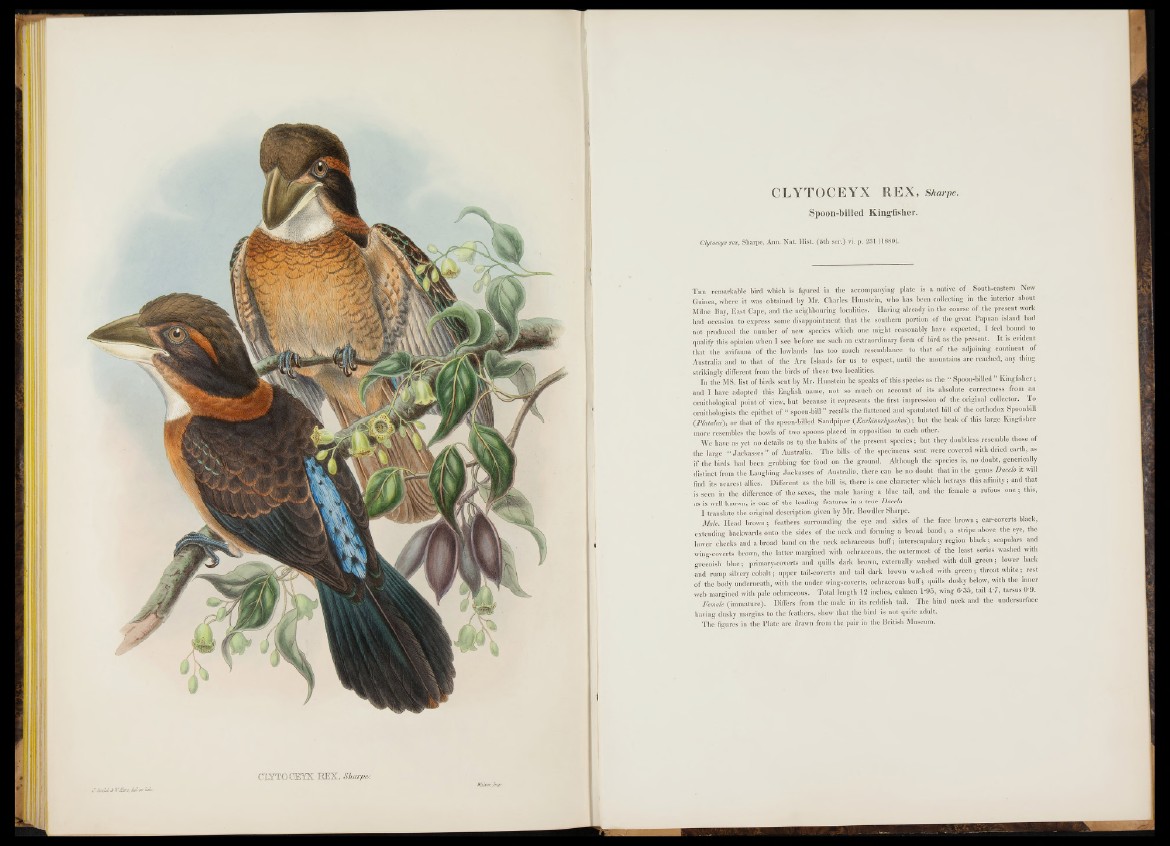
CLYTOCEYX REX, sharVe.
Spoon-billed Kingfisher.
Clytoceyx rex, Sharpe, Ann. Nat. Hist. (5th ser.) vi. p. 231 (1880).
T he remarkable bird which is figured in the accompanying plate is a native o f South-eastern New
Guinea, where it was obtained by Mr. Charles Hunstein, who has been collecting in the interior about
Milne Bay, East Cape, and the neighbouring localities. Having already in the course of, the present work
had occasion to express some disappointment that the southern portion o f the great Papuan island had
not produced the number of new species which one might reasonably have expected, I feel bound to
qualify thisiffljfinion when I see before me such an extraordinary form of bird as the present. I t is evident
th at the avifauna of the lowlands has too much resemblance to that of the adjoining continent of
Australia and to th at of the Aru Islands for us to expect; until the mountains are reached, any thing
strikingly different from the birds o f these two localities.
In the MS. list of birds sent by Mr. Hunstein he speaks o f this species as the “ Spoon-billed " Kingfisher;
and I have adopted this English name, not so much on account of its absolute correctness from an
ornithological point o f view, but because i t represents the first impression of the original collector. To
ornithologists the epithet o f “ spoon-bill ” recalls the flattened and spatulated bill of the orthodox Spooubill
(Platalea), or th at of the spoon-billed Sandpiper (JZurhinorhynchus) ; but the beak of this large Kingfisher
more resembles the bowls o f two spoons placed in opposition to each other.
We have as yet no details as to the habits o f the present species; but they doubtless resemble those of
the large “ Jackasses ” o f Australia. T h e hills of the specimens sent were covered with dried earth, as
if the birds had been grubbing for food on the ground. Although the species is, no doubt, generically
distinct from the Laughing Jackasses o f Australia, there can be no doubt that in the genus Dacelo it will
find its nearest allies. Different as the bill is, there is one character which betrays this aflimty; and that
is seen in the difference o f the sexes, the male having a blue tail, and the female a rufous o n e ; this,
as is well known, is one o f the leading features in a true Dacelo.
I translate the original description given by Mr. Bowdler Sharpe.
Male. Head brown; feathers surrounding the eye and- sides o f the face brown ; eai-coverts black,
extending backwards onto the sides o f the neck and forming a broad b an d ; a stripe above the eye, the
-lower cheeks and a broad band on the neck ochraceous buff; interscapulary region black ; scapulars and
wing-coverts brown, the latter margined with ochraceous, the outermost o f the least series washed with
greenish blu e; primary-coverts and quills dark brown, externally washed with dull g reen ; lower back
and rump silvery co b a lt; upper tail-coverts and tail dark brown washed with g ree n ; throat wh ite; rest
of the body underneath, with the under wing-coverts, ochraceous buff; quills dusky below, with the inner
web margined with pale ochraceous. Total length 12 inches, culmen 1-95, wing 6-35, tail 4 7 , tarsus 0-9.
Female (immature). Differs from the male in its reddish tail. The hind neck and the undersurface
having dusky margins to the feathers, show that the bird is not quite adult.
The figures in the Plate are drawn from the pair in the British Museum.